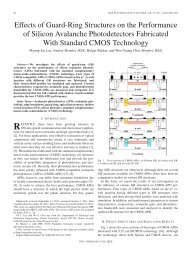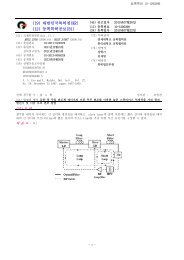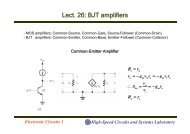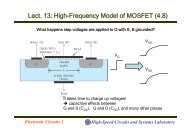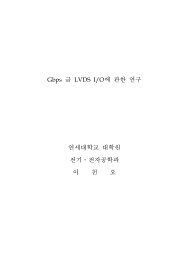Lect. 17: BJT Emitter Follower (Razavi 5.3.3)
Lect. 17: BJT Emitter Follower (Razavi 5.3.3)
Lect. 17: BJT Emitter Follower (Razavi 5.3.3)
You also want an ePaper? Increase the reach of your titles
YUMPU automatically turns print PDFs into web optimized ePapers that Google loves.
<strong>Lect</strong>. <strong>17</strong>: <strong>BJT</strong> <strong>Emitter</strong> <strong>Follower</strong>Output ResistanceR r ||β +1= π out|| R EElectronic Circuits 1 (09/2)Prof. Woo-Young Choi
<strong>Lect</strong>. <strong>17</strong>: <strong>BJT</strong> <strong>Emitter</strong> <strong>Follower</strong>Common-Collector or <strong>Emitter</strong> <strong>Follower</strong>-R in : Large-R out : Smallout- Voltage Gain: Close to unity Voltage BufferElectronic Circuits 1 (09/2)Prof. Woo-Young Choi
<strong>Lect</strong>. <strong>17</strong>: <strong>BJT</strong> <strong>Emitter</strong> <strong>Follower</strong>Voltage AmplifierWith R L , R o should be as small as possibleWhat if a given amplifier configuration does not have small R o(for example CE)?Use voltage buffer, or emitter follower!Electronic Circuits 1 (09/2)Prof. Woo-Young Choi



